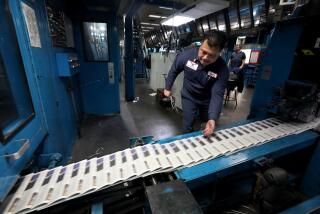On the Media: Patch.com’s Newark plan smells of conflict
Imagine if the San Francisco Chronicle beefed up coverage of the state capital and asked Gov. Jerry Brown which agencies deserved the most coverage. Or what if Fox News planned to take a closer look at the United Nations with the blessing of Secretary-General Ban Ki-moon?
The snickering that ensued would be prolonged, followed by a righteous blast of indignation from other news outlets. Journalism born out of such cooperation would rightly stink of conflict.
That will be at least the initial aroma around the latest journalistic initiative by America’s fastest-growing news outlet, Patch.com. The AOL-owned operation announced this week that it would open hyper-local news sites in Newark, N.J., “in partnership with Newark Mayor Cory Booker.”
It doesn’t really matter whether Patch’s executive overseer, Arianna Huffington, is merely a good friend of Mayor Booker, as she says, or had a romantic relationship with him, as others have suggested. Either way, the new journalistic arrangement looks just a little too cozy. Booker is helping pick the neighborhoods where Patch will set roots, and the outlet’s president, Warren Webster, gushed about his desire “to work closely with Mayor Booker to bring neighborhood journalism, information and social interactivity to one of America’s great cities.”
Maybe the mayor will be hooking paragraphs, cropping photos and suggesting features about his favorite City Hall allies. All in the spirit of synergy and good government, right? Not to be a spoilsport, but whatever happened to journalistic reserve? Did the expiration date on arm’s-length relationships pass while I was out getting popcorn?
Apparently, those old values can be subsumed by the wonders of synergy and new technology — the latter close to the heart of both Newark’s reform mayor (who took snowplow requests this winter via Twitter!) and America’s Internet doyenne.
The latest Huffington alliance will come as no surprise to those who have watched her parlay super-charged networking (and considerable smarts) to build her Huffington Post into one of the biggest brands on the Internet. Her ability to succeed (to the tune of 24 million unique visitors a month, according to ComScore) while relying largely on others (sometimes unpaid) makes her a frequent target for barbs — such as the biting essay by New York Times editor Bill Keller last week. The Times boss compared Huffington’s reliance on aggregation to counterfeiting money.
And scrutiny of Huffington will only increase, following AOL’s purchase last month of Huffington Post, a $315-million transaction that made Arianna not only head of her site but of all AOL content. The deal completed her transformation from back-bench agitator to one of the biggest forces in American media.
One of her most important new playthings is Patch.com. With about 900 sites spread across 18 states and the District of Columbia, the operation has been hiring more journalists than any other. Patch promises neighborhood-level coverage, mostly in affluent communities that AOL hopes together will lure big national advertisers.
The website designed the move into two Newark neighborhoods, yet to be named, to show it’s also willing to cover less fortunate places. Huffington said the embrace of the have-nots has already been demonstrated by the Patch.com site that covers the Bedford-Stuyvesant section of Brooklyn, N.Y.
She assured me in an interview that, despite Mayor Booker’s help in getting the new sites rolling, he would get no favored treatment.
“We talked to Cory and his team and they know very well they may be criticized. I’m sure they will be,” Huffington said. “It will be great to have their help, since they are so plugged into the community, to help us identify the places to start. But that does not in any way immunize them from criticism or … the kind of journalism we would need to engage in.”
“I have known Cory for a long time and written about him for many years,” she continued. “I admire what he has achieved. He has been really amazing, what he has done in that community. But it doesn’t mean if things need to be criticized they won’t be criticized.”
So she loves him (figuratively) but will tell him when he’s wrong.
Huffington said I reached her too soon to provide more news, but that other under-served communities will soon be covered by Patch. She’s engaged in an intense series of meetings this week to plot strategy for the sites, including how to staff the micro news operations.
Patch has been plagued from the start by a difficult dilemma not dissimilar from the one facing much of the media online — how to get enough content out of one local editor and a cadre of freelancers while controlling payroll costs enough to make a profit, given wickedly low Internet ad rates.
Local editors have tended to make up the content gap themselves, working brutal hours and occasionally burning out. More than a few of the exhausted pioneers have left 4-year-old Patch, despite the tough prospects of finding jobs elsewhere.
That’s not to discount the other Patch editors who tell me they are thrilled to be in the game and building something new. Some of them have been able to draw on the pool of experienced journalists available for reporting as traditional outlets contract.
(Disclosure: My wife is a former magazine editor and television producer who has written several freelance pieces for Patch.com. She gets $60 an article, a fairly standard rate for the site.)
Patch employees share with their older-media cousins an ongoing anxiety about what comes next. Several site editors complained to me around the time of the AOL-HuffPo deal in early February that they had been ordered to slash their freelance budgets.
“We will not be cutting anything,” Huffington pledged in our conversation Tuesday. Webster said via a spokeswoman that the company might be “changing what we spend money on, but the net investment in content has only increased.”
The hyper-local Patch sites I dip into are a wildly mixed bunch. The best editors deliver real news, covering stories that bigger outlets rarely get to. Prep sports can receive better play than in regional newspapers, which simply can’t get to everything.
But most of what I see on Patch seems pro forma, the coverage of government tending to a stenography of the status quo. That doesn’t seem to be by intention, or lack of effort. It turns out it’s easier to commit to breaking news and probing beneath the surface than to actually do it, especially with thin staffing and part-timers doing much of the heavy lifting.
Hopefully, the Patch partnership with Newark’s mayor isn’t emblematic of more of the same. Even with her hundreds of Patch journalists spread thinly across the land, Huffington commands a substantial army. It would be nice to see them not just holding their positions, but reconstructing the battlefield to help not just her pals but her readers.
Twitter: latimesrainey
More to Read
The biggest entertainment stories
Get our big stories about Hollywood, film, television, music, arts, culture and more right in your inbox as soon as they publish.
You may occasionally receive promotional content from the Los Angeles Times.











